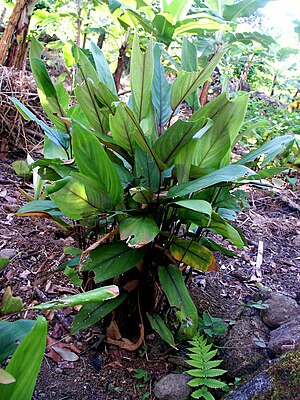Note: This is a project under development. The articles on this wiki are just being initiated and broadly incomplete. You can Help creating new pages.
Difference between revisions of "Maranta arundinacea"
(→Common names) |
(→Identification) |
||
| Line 35: | Line 35: | ||
==Identification== | ==Identification== | ||
===Leaf=== | ===Leaf=== | ||
| − | {{Leaf|Simple|Distichous|Ovate-lanceolate; | + | {{Leaf|Simple|Distichous|Ovate-lanceolate; Petiole sheathing, Pulvinate}}<ref name="Leaf"/> |
===Flower=== | ===Flower=== | ||
| − | {{Flower|Bisexual|Pairs on long|White||Branched peduncles, in terminal cyme. Sepals 3. Corolla tubular below, 3-lobed above | + | {{Flower|Bisexual|Pairs on long|White||Branched peduncles, in terminal cyme. Sepals 3. Corolla tubular below, 3-lobed above.}} |
Latest revision as of 17:38, 25 November 2020
Maranta arundinacea, also known as arrowroot, maranta, West Indian arrowroot, obedience plant, Bermuda arrowroot, araru, araruta, ararao or hulankeeriya, is a large, perennial herb found in rainforest habitats. Arrowroot flour is now produced commercially mostly in St. Vincent and the Grenadines.
Contents
- 1 Uses
- 2 Parts Used
- 3 Chemical Composition
- 4 Common names
- 5 Properties
- 6 Habit
- 7 Identification
- 8 List of Ayurvedic medicine in which the herb is used
- 9 Where to get the saplings
- 10 Mode of Propagation
- 11 How to plant/cultivate
- 12 Commonly seen growing in areas
- 13 Photo Gallery
- 14 References
- 15 External Links
Uses
Urinary problems, Menorrhea, Strangury, Digestive troubles
Parts Used
Chemical Composition
The tuber contains Starch (25-30%), moisture 64%, crude protein 1.6%, fat 0.2%, dextrin and sugars 2.1% and crude fibre 3.9%.[1]
Common names
| Language | Common name |
|---|---|
| Kannada | Araaruta |
| Hindi | Araaruta |
| Malayalam | |
| Tamil | Aruruttukkilangu |
| Telugu | Palagunda |
| Marathi | NA |
| Gujarathi | NA |
| Punjabi | NA |
| Kashmiri | NA |
| Sanskrit | Sita tavakshira |
| English | Arrowroot Plant, True arrowroot |
Properties
Reference: Dravya - Substance, Rasa - Taste, Guna - Qualities, Veerya - Potency, Vipaka - Post-digesion effect, Karma - Pharmacological activity, Prabhava - Therepeutics.
Dravya
Rasa
Madhura (Sweet)
Guna
Guru (Heavy), Snigdha (Unctuous)
Veerya
Shita (Cooling)
Vipaka
Madhura (Sweet)
Karma
Kapha, Vata
Prabhava
Habit
Identification
Leaf
| Kind | Shape | Feature |
|---|---|---|
| Simple | Distichous | Ovate-lanceolate; Petiole sheathing, Pulvinate |
Flower
| Type | Size | Color and composition | Stamen | More information |
|---|---|---|---|---|
| Bisexual | Pairs on long | White | Branched peduncles, in terminal cyme. Sepals 3. Corolla tubular below, 3-lobed above. |
Other features
List of Ayurvedic medicine in which the herb is used
Where to get the saplings
Mode of Propagation
Propagation is done by the mature tips of the rhizome..
How to plant/cultivate
High humid, warm and shady places. Well drained alluvial and volcanic soil.[3]
Commonly seen growing in areas
Cultivated in all tropical regions.
Photo Gallery
References
External Links
- Ayurvedic Herbs known to be helpful to treat Urinary problems
- Ayurvedic Herbs known to be helpful to treat Menorrhea
- Ayurvedic Herbs known to be helpful to treat Strangury
- Ayurvedic Herbs known to be helpful to treat Digestive troubles
- Herbs with Leaves used in medicine
- Herbs with Stem used in medicine
- Herbs with Roots used in medicine
- Herbs with common name in Kannada
- Herbs with common name in Hindi
- Herbs with common name in Tamil
- Herbs with common name in Telugu
- Herbs with common name in Sanskrit
- Herbs with common name in English
- Habit - Tall herb
- Index of Plants which can be propagated by Propagation is done by the mature tips of the rhizome.
- Herbs that are commonly seen in the region of Cultivated in all tropical regions
- Herbs
- Marantaceae



